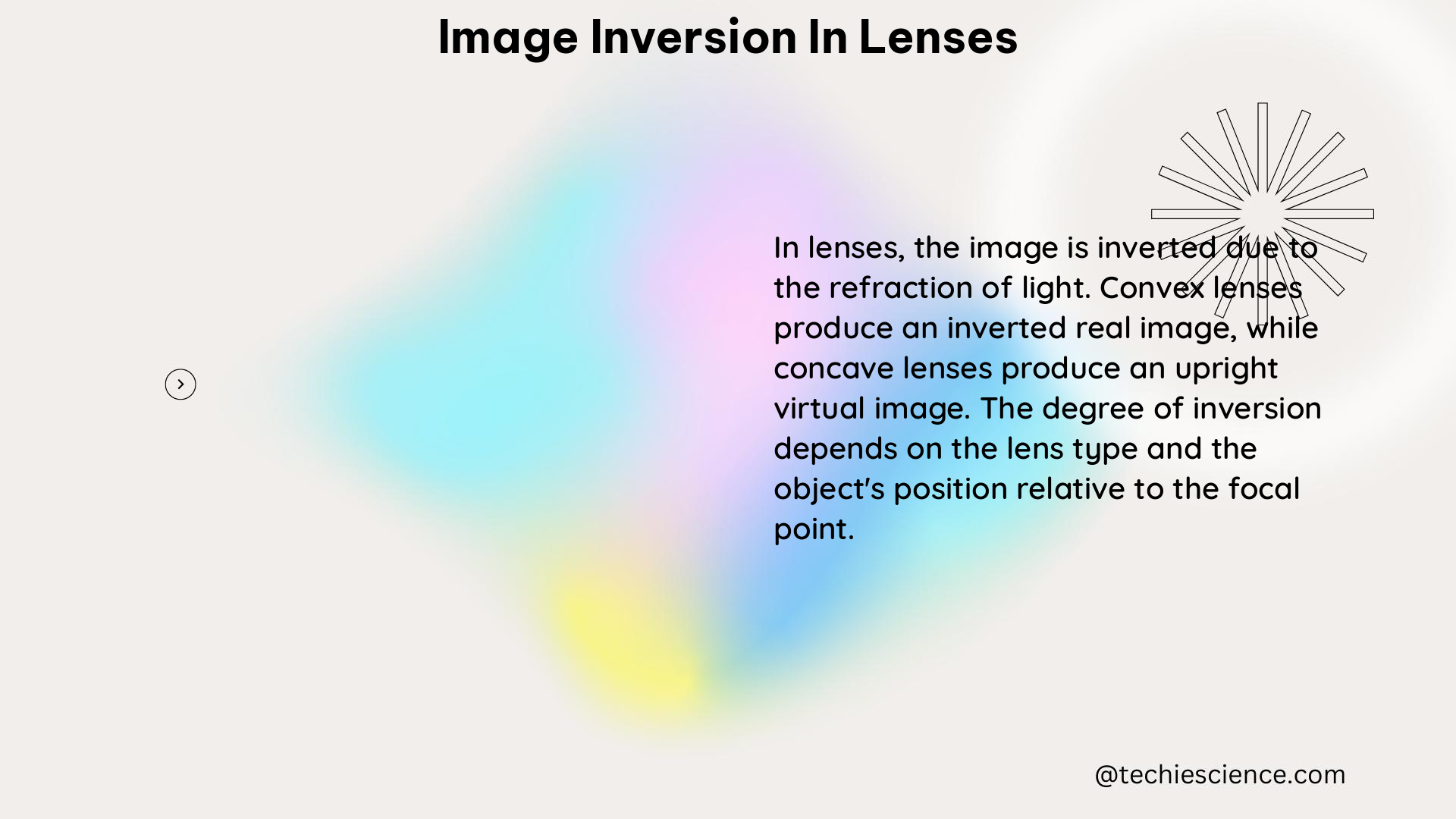Image inversion in lenses is a fundamental concept in physics and optics, where the image formed by a lens is inverted or flipped with respect to the original object. This phenomenon occurs due to the refraction of light as it passes through the lens. Understanding the principles of image inversion in lenses is crucial for the design and use of various optical instruments, such as cameras, microscopes, and eyeglasses.
The Lens Equation and Image Inversion
The physics formula that describes image inversion in lenses is the lens equation, which is given by:
1/f = 1/do + 1/di
where:
– f is the focal length of the lens
– do is the object distance
– di is the image distance
The focal length of a lens is a measure of its optical power and is defined as the distance from the center of the lens to the point where parallel rays of light converge or diverge.
Sign Convention for the Lens Equation
The sign convention for the lens equation is as follows:
- The focal length (
f) is positive for converging lenses (also known as convex lenses) and negative for diverging lenses (also known as concave lenses). - The object distance (
do) is positive if the object is located in front of the lens and negative if it is located behind the lens. - The image distance (
di) is positive if the image is real and located in front of the lens, and negative if the image is virtual and located behind the lens.
Calculating Focal Length Using the Lens Equation
Using the lens equation, we can calculate the focal length of a lens based on the object and image distances. For example, if an object is placed 20 cm in front of a converging lens and a real image is formed 40 cm in front of the lens, we can calculate the focal length of the lens using the following formula:
1/f = 1/20 cm + 1/40 cm
Solving for f, we get:
f = 13.33 cm
This means that the lens has a focal length of 13.33 cm and is therefore a converging lens.
The Thin Lens Equation and Image Inversion

The theorem that describes image inversion in lenses is the thin lens equation, which is a simplified version of the lens equation that assumes the lens is thin and does not introduce significant distortion. The thin lens equation is given by:
1/f = (n - 1)(1/R1 - 1/R2)
where:
– f is the focal length of the lens
– n is the refractive index of the lens material
– R1 and R2 are the radii of curvature of the lens surfaces
Physics Examples of Image Inversion in Lenses
Examples of image inversion in lenses include:
- Convex Lenses in Cameras and Microscopes: Convex lenses are used in cameras and microscopes to form real, inverted images of objects.
- Concave Lenses in Eyeglasses: Concave lenses are used in eyeglasses to correct nearsightedness by forming virtual, upright images of objects.
Physics Numerical Problems Involving Image Inversion
Numerical problems that involve image inversion in lenses include:
- Calculating Focal Length: Determining the focal length of a lens based on the object and image distances.
- Determining Magnification: Calculating the magnification of an image formed by a lens. The magnification (M) is given by:
M = -di/do
where di is the image distance and do is the object distance. The negative sign indicates that the image is inverted.
Figures and Data Points Illustrating Image Inversion
Figures and data points that illustrate image inversion in lenses include:
- Ray Diagrams: These diagrams show the path of light rays as they pass through a lens and form an image. Ray diagrams can be used to determine the location and size of the image, as well as whether the image is real or virtual.
- Lens Focal Length and Image Distance Data: Tabulated data showing the relationship between the focal length of a lens, the object distance, and the image distance, and how these parameters affect the formation of the inverted image.
- Lens Magnification Data: Numerical data demonstrating the magnification of images formed by lenses with different focal lengths and object-image distances.
Conclusion
Image inversion in lenses is a fundamental concept in physics and optics that is described by the lens equation and the thin lens equation. Understanding the principles of image inversion is crucial for the design and use of various optical instruments, such as cameras, microscopes, and eyeglasses. By mastering the concepts and equations related to image inversion in lenses, physics students can solve a wide range of numerical problems and gain a deeper understanding of the behavior of light in optical systems.
References
- Lenses Virtual Lab using PhET Geometric Optics, Course Hero. Link
- Image formation in convex lenses, ResearchGate. Link
- The Mathematics of Lenses, The Physics Classroom. Link

The lambdageeks.com Core SME Team is a group of experienced subject matter experts from diverse scientific and technical fields including Physics, Chemistry, Technology,Electronics & Electrical Engineering, Automotive, Mechanical Engineering. Our team collaborates to create high-quality, well-researched articles on a wide range of science and technology topics for the lambdageeks.com website.
All Our Senior SME are having more than 7 Years of experience in the respective fields . They are either Working Industry Professionals or assocaited With different Universities. Refer Our Authors Page to get to know About our Core SMEs.